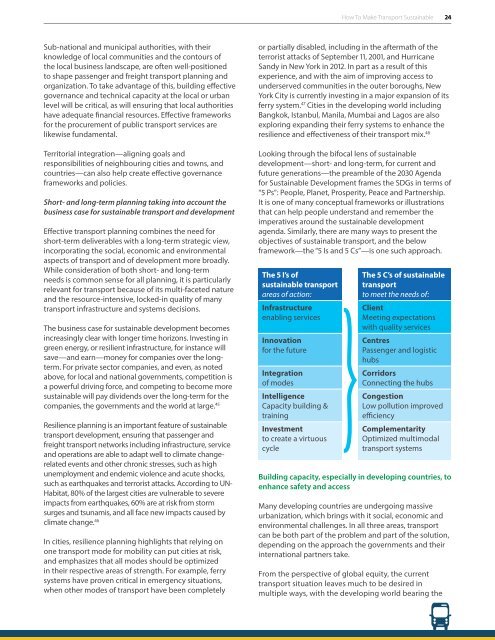MOBILIZING DEVELOPMENT
a5OQ306q56U
a5OQ306q56U
Create successful ePaper yourself
Turn your PDF publications into a flip-book with our unique Google optimized e-Paper software.
How To Make Transport Sustainable 24<br />
Sub-national and municipal authorities, with their<br />
knowledge of local communities and the contours of<br />
the local business landscape, are often well-positioned<br />
to shape passenger and freight transport planning and<br />
organization. To take advantage of this, building effective<br />
governance and technical capacity at the local or urban<br />
level will be critical, as will ensuring that local authorities<br />
have adequate financial resources. Effective frameworks<br />
for the procurement of public transport services are<br />
likewise fundamental.<br />
Territorial integration—aligning goals and<br />
responsibilities of neighbouring cities and towns, and<br />
countries—can also help create effective governance<br />
frameworks and policies.<br />
Short- and long-term planning taking into account the<br />
business case for sustainable transport and development<br />
Effective transport planning combines the need for<br />
short-term deliverables with a long-term strategic view,<br />
incorporating the social, economic and environmental<br />
aspects of transport and of development more broadly.<br />
While consideration of both short- and long-term<br />
needs is common sense for all planning, it is particularly<br />
relevant for transport because of its multi-faceted nature<br />
and the resource-intensive, locked-in quality of many<br />
transport infrastructure and systems decisions.<br />
The business case for sustainable development becomes<br />
increasingly clear with longer time horizons. Investing in<br />
green energy, or resilient infrastructure, for instance will<br />
save—and earn—money for companies over the longterm.<br />
For private sector companies, and even, as noted<br />
above, for local and national governments, competition is<br />
a powerful driving force, and competing to become more<br />
sustainable will pay dividends over the long-term for the<br />
companies, the governments and the world at large. 45<br />
Resilience planning is an important feature of sustainable<br />
transport development, ensuring that passenger and<br />
freight transport networks including infrastructure, service<br />
and operations are able to adapt well to climate changerelated<br />
events and other chronic stresses, such as high<br />
unemployment and endemic violence and acute shocks,<br />
such as earthquakes and terrorist attacks. According to UN-<br />
Habitat, 80% of the largest cities are vulnerable to severe<br />
impacts from earthquakes, 60% are at risk from storm<br />
surges and tsunamis, and all face new impacts caused by<br />
climate change. 46<br />
In cities, resilience planning highlights that relying on<br />
one transport mode for mobility can put cities at risk,<br />
and emphasizes that all modes should be optimized<br />
in their respective areas of strength. For example, ferry<br />
systems have proven critical in emergency situations,<br />
when other modes of transport have been completely<br />
or partially disabled, including in the aftermath of the<br />
terrorist attacks of September 11, 2001, and Hurricane<br />
Sandy in New York in 2012. In part as a result of this<br />
experience, and with the aim of improving access to<br />
underserved communities in the outer boroughs, New<br />
York City is currently investing in a major expansion of its<br />
ferry system. 47 Cities in the developing world including<br />
Bangkok, Istanbul, Manila, Mumbai and Lagos are also<br />
exploring expanding their ferry systems to enhance the<br />
resilience and effectiveness of their transport mix. 48<br />
Looking through the bifocal lens of sustainable<br />
development—short- and long-term, for current and<br />
future generations—the preamble of the 2030 Agenda<br />
for Sustainable Development frames the SDGs in terms of<br />
“5 Ps”: People, Planet, Prosperity, Peace and Partnership.<br />
It is one of many conceptual frameworks or illustrations<br />
that can help people understand and remember the<br />
imperatives around the sustainable development<br />
agenda. Similarly, there are many ways to present the<br />
objectives of sustainable transport, and the below<br />
framework—the “5 Is and 5 Cs”—is one such approach.<br />
The 5 I’s of<br />
sustainable transport<br />
areas of action:<br />
Infrastructure<br />
enabling services<br />
Innovation<br />
for the future<br />
Integration<br />
of modes<br />
Intelligence<br />
Capacity building &<br />
training<br />
Investment<br />
to create a virtuous<br />
cycle<br />
The 5 C’s of sustainable<br />
transport<br />
to meet the needs of:<br />
Client<br />
Meeting expectations<br />
with quality services<br />
Centres<br />
Passenger and logistic<br />
hubs<br />
Corridors<br />
Connecting the hubs<br />
Congestion<br />
Low pollution improved<br />
efficiency<br />
Complementarity<br />
Optimized multimodal<br />
transport systems<br />
Building capacity, especially in developing countries, to<br />
enhance safety and access<br />
Many developing countries are undergoing massive<br />
urbanization, which brings with it social, economic and<br />
environmental challenges. In all three areas, transport<br />
can be both part of the problem and part of the solution,<br />
depending on the approach the governments and their<br />
international partners take.<br />
From the perspective of global equity, the current<br />
transport situation leaves much to be desired in<br />
multiple ways, with the developing world bearing the


